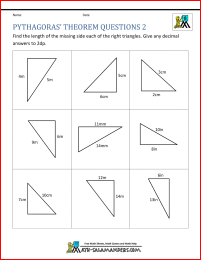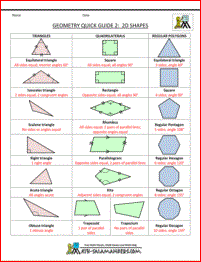- Home |
- About |
- Contact Us |
- Privacy |
- Newsletter |
- Shop |
- Donate
Geometry Formulas Triangles

Welcome to the Math Salamanders' Geometry Formulas Triangles area.
Here you will find information about the properties of triangles and
different triangle formulas and theorems.
Shape Clipart
The Math Salamanders have a large bank of free printable shape clipart.
Each of the printable shape sheets is available either in color or black and white.
Using this shape clipart will help your child understand to recognize shapes and learn
about the different properties that shapes have.
On the sheets with multiple shapes, we have shown the shapes in different sizes and orientations so that
your child will recognize variations of the same shape, and start noticing the properties the same shapes all have.
The sheets can be used as part of a Math display, as flashcards, or as printable coloring sheets.
Geometry Formulas Triangles
Here you will find our support page on triangles, including properties of triangles and triangle formulas and theorems.
At the bottom of each section you will also find a printable version of parts of this Geometry Formulas Triangles web-page.
Using these sheets will help your child to:
- understand the different properties of triangles;
- learn and use triangle formulas
Properties of Triangles
Triangles have the following properties:
- All triangles have 3 straight sides, 3 corners (vertices), and 3 angles.
- All triangles have angles adding up to 180°.
Types of Triangle

|

|

|
| Equilateral Triangle | Isosceles Triangle | Scalene Triangle |
Equilateral Triangles
Equilateral triangles have the following properties (in addition to the properties above for all triangles):
- Three straight sides of equal length;
- Three angles, all equal to 60°;
- Three lines of symmetry.
Isosceles Triangles
Isosceles triangles have the following properties:
- Two sides of equal length;
- Two equal angles;
- One line of symmetry.
Please note: according to Wikipedia:
" In geometry, an isosceles triangle is a triangle that has two sides of equal length. Sometimes it is specified as having two and only two sides of equal length, and sometimes as having at least two sides of equal length, the latter version thus including the equilateral triangle as a special case. "
Source: https://en.wikipedia.org/wiki/Isosceles_triangle
This means that there is some dispute as to whether an equilateral triangle is a special case of an isosceles triangle or not!
Most modern textbooks include use the 'at least' definition for isosceles triangles.
Scalene Triangles
Scalene triangles have the following properties:
- No sides of equal length;
- No equal angles;
- No lines of symmetry.
Angles in a Triangle
Here is some handy information about the angles in different triangles.

|

|

|
| Acute Triangle | Right Triangle | Obtuse Triangle |
Acute triangles
Acute triangles have all acute angles (all angles are less than 90°).
It is possible to have an acute triangle which is also an isosceles triangle - these are called acute isosceles triangles.
Right triangles
Right Triangles (right-angled triangles) have one right angle (equal to 90°).
It is possible to have a right isosceles triangle - a triangle with a right angle and two equal sides.
Obtuse triangles
Obtuse triangles have one obtuse angle (angle which is greater than 90°).
It is possible to have a obtuse isosceles triangle - a triangle with an obtuse angle and two equal sides.
Properties of Triangles Printable Sheets
If you would like a printable version of the support page above on properties of triangles, use the link below.
Geometry Formulas Triangles
Below are some of the triangle formulas and theorems for our Geometry Formulas Triangles page.
Geometry Formulas Triangles - Angles in a Triangle
The angles in a triangle add up to 180°.
This can be shown using the following simple demonstration.
Step 1
Draw a triangle on a piece of paper. Mark the 3 angles a, b and c.

Step 2
Cut out (or tear out) the three angles.

Step 3
Put the angles a, b and c together. They should make a straight line when placed together, which is equivalent to 180°.

Missing Angle in a Triangle Example
Find the missing angle in the triangle below.

We know that all three angles in the triangle must add up to 180°.
So we know that ? + 128 + 23 = 180.
This means that ? = 180 - 128 - 23 = 29°.
So the missing angle is 29°.
Geometry Formulas Triangles - Area of a Triangle
The area of a triangle is equal to half of the base multiplied by the perpendicular height of the triangle.

|

|
| A right triangle showing height and base. | A non-right triangle showing height and base. |
Area of a triangle
The Area of a triangle is \[ {1 \over 2} \times base \times height \; \] \[ = \; {1 \over 2} b h \]
In a right triangle (left image) then we simply need to multiply the 2 sides together which are adjacent to the right angle, and then halve the answer.
In a triangle which is not a right triangle (right image), then we need to find the perpendicular height of the triangle.
We can find the perpendicular height by dropping a vertical line down from the highest point on the triangle to the base (with the longest side set horizontal).
Finally, we find the area by multiplying the base by this perpendicular height and halving the answer.
Example

The area of this triangle is \[{1 \over 2} bh = {1 \over 2} \times 6 \times 3 = 9cm^2 \]
Why does this work?
If we look at the rectangle below, we can see that it has twice the area of the blue triangle inside it because the two yellow triangles are exactly the same size as the two sub-divided blue triangles.

The area of this rectangle is base x height, so the area of the triangle is half of this which is \[{1 \over 2} \times base \times height \]
Geometry Formulas Triangles - Pythagoras' Theorem
Pythagoras' theorem states that in a right triangle (or right-angled triangle) the sum of the squares of the two smaller sides of the triangle is equal to the square of the hypotenuse.

In other words, \[a^2 + b^2 = c^2 \]
where c is the hypotenuse (the longest side) and a and b are the other sides of the right triangle.
What does this mean?
This means that for any right triangle, the orange square (which is the square made using the longest side) has the same area as the other two blue squares added together.

Other formulae
As a result of the formula \[a^2 + b^2 = c^2 \] we can also deduce that:
- \[b^2 = c^2 - a^2 \; and\]
- \[ a^2 = c^2 - b^2 \]
Square rooting the 3 equations above gives us:
- \[ c = \sqrt {a^2 + b^2} \]
- \[ b = \sqrt {c^2 - a^2} \]
- \[ a = \sqrt {c^2 - b^2} \]
Examples using Pythagoras' Theorem
Example 1) Find the missing side of this triangle.

In this example, we need to find the hypotenuse (longest side of a right triangle).
So using pythagoras, the sum of the two smaller squares is equal to the square of the hypotenuse.
This gives us: \[ 4^2 + 6^2 \; = \; ?^2 \]
Which means that \[ ?^2 = 16 + 36 = 52 \]
So \[ ? = \sqrt {52} = 7.21 \; to \; 2dp \]
Example 2) Find the missing side of this triangle.

In this example, we need to find the length of the base of the triangle, given the other two sides.
So using pythagoras, the sum of the two smaller squares is equal to the square of the hypotenuse.
This gives us \[ ?^2 \; + \; 5^2 \; = \; 8^2 \]
So \[ ?^2 \; = \; 8^2 \; - \; 5^2 \; = \; 64 - 25 \; = \; 39 \]
So \[ ? \; = \; \sqrt {39} \; = \; 6.25 \; to \; 2dp \]
Pythagoras' Theorem Support
Geometry Formulas Triangles - Basic Triangle Trigonometry
In basic triangle trigonometry, we look at three trigonometric functions: sine, cosine and tangent (sin, cos and tan) with right triangles.

Let us start by naming the parts of this triangle.
θ is one of the angles of the right triangle (but not the right angle!)
h is the hypotenuse - the longest side of the right triangle
o is opposite to the angle
a is adjacent to the angle
The three formulas to rememeber can be summed up in one acronym:
SOH CAH TOA
where s stands for sine, c for cosine and t for tangent.
The three formulas are written below:
\[ \sin (θ) \; = \; {o \over h} \] \[ \cos (θ) \; = \; {a \over h} \] \[ \tan (θ) \; = \; {o \over a} \]
Basic Trigonometry Examples
Example 1) Find the length of the hypotenuse

In the triangle below, we have been given the angle which is 35°
We have also been told the length of the adjacent side a, which is 8cm.
We need to find out the length of the hypotenuse h.
So as the letters a and h are the two letters involved, we need the cosine operation (CAH).
So the formula we need is \[ \cos (θ) \; = \; {a \over h} \]
So \[ \cos (35°) = {8cm \over ?} \]
This means that \[ ? \; = \; {8cm \over \cos (35° ) } \]
So \[ ? \; = \; 9.77cm \; to \; 2dp.\]
Example 2) Find the length of the missing side

In the triangle below, we have been given the angle, which is 48°.
We have also been told the adjacent side a, which is 11m.
We need to find out the length of the opposite side o.
So as the letters o and a are the two letters involved, we need the tangent operation (TOA).
The formula we need is: \[ \tan (θ) \; = \; {o \over a} \]
So \[ \tan (48°) \; = \; {? \over 11} \]
So \[ ? \; = \; 11 \times \tan (48°) \; = \; 12.22m \; to \; 2dp \]
Example 3) Find the length of the missing side.

In this triangle, we need to find the length of the opposite side of the triangle.
We have been given the angle and the hypotenuse.
So as the letters o and h are used, we need the sine operation (SOH).
The formula we need is: \[ \sin (θ) \; = \; {o \over h} \]
So \[ \sin (42° ) \; = \; {? \over 4.2} \]
So \[ ? \; = \; 4.2 \times \sin (42° ) \; = \; 2.81cm \; to \; 2dp \]
Sine, Cosine & Tangent Formulas Support Sheet
Geometry Formulas Triangles - The Sine and Cosine Rules
The basic triangle trigonometry formulas above will only work for right triangles - they will not work for triangles without right angles.
The following formulas below will work for any triangle.
Again, if we start with the naming of the sides and angles of the triangle:

a is the side opposite angle A;
b is the side opposite angle B;
c is the side opposite angle C.
The sine rule states that: \[ { a \over \sin A} \; = \; {b \over \sin B} \; = \; {c \over \sin C} \]
The Cosine rule states that:
\[ a^2 \; = \; b^2 \; + \; c^2 \; - \; 2bc \; \cos A \]
OR
\[ \cos A \; = {b^2 \; + \; c^2 \; - \; a^2 \over 2bc} \]
Sine & Cosine Rule Examples
Example 1) Find the missing side.

In this example, we have been given 2 of the angles, but only one side measurement.
The rule we need is the sine rule, as 2 angles are involved.
So using the sine rule gives us:
\[ {12 \over \sin (123° )} \; = \; { ? \over \sin (27° )} \]
So this means that:
\[ ? \; = \; { 12 \times \sin (27° ) \over \sin (123° )} \]
So \[ ? \; = \; 6.50cm \; to \; 2dp. \]
Example 2)
Find the missing angle in the triangle below. Give your answer to 1 decimal place.

In this example, we have been given three sides and we need to find the angle.
The rule we need is the cosine rule which involves 3 sides and one angle.
It is easier to use the cos A formula, as it is the angle we want to find.
\[ \cos (A) \; = \; {b^2 \; + \; c^2 \; - \; a^2 \over 2bc} \]
Using ? as our angle A, this gives us: \[ \cos (?) \; = \; {10^2 \; + \; 11^2 \; - \; 6^2 \over 2 \times 10 \times 11} \]
So \[ \cos (?) \; = \; {185 \over 220} \; = \; {37 \over 44}\]
This means that: \[ ? \; = \; \cos^{-1} {37 \over 44} \]
This gives us: \[ ? \; = \; 32.8° \; to \; 1dp \]
Sine & Cosine Rule Support Sheets
More Recommended Math Worksheets
Take a look at some more of our worksheets similar to these.
Geometry Formula Sheet
Here you will find a support page packed with a range of geometric formula.
Included in this page are formula for:
- areas and volumes of 2d and 3d shapes
- interior angles of polygons
- angles of 2d shapes
- triangle formulas and theorems
This page will provide a useful reference for anyone needing a geometric formula.
Geometry Cheat Sheets
Here you will find a range of geometry cheat sheets to help you answer a range of geometry questions.
The sheets contain information about angles, types and properties of 2d and 3d shapes, and also common formulas associated with 2d and 3d shapes.
Included in this page are:
- images of common 2d and 3d shapes;
- properties of 2d and 3d shapes;
- formulas involving 2d shapes, such as area and perimeter, pythagoras' theorem, trigonometry laws, etc;
- formulas involving 3d shapes about volume and surface area.
Using the sheets in this section will help you understand and answer a range of geometry questions.
How to Print or Save these sheets 🖶
Need help with printing or saving?
Follow these 3 steps to get your worksheets printed perfectly!
How to Print or Save these sheets 🖶
Need help with printing or saving?
Follow these 3 steps to get your worksheets printed perfectly!
Subscribe to Math Salamanders News
Sign up for our newsletter and get free math support delivered to your inbox each month. Free seasonal math grab pack included.
Math-Salamanders.com

The Math Salamanders hope you enjoy using these free printable Math worksheets and all our other Math games and resources.
We welcome any comments about our site or worksheets on the Facebook comments box at the bottom of every page.











New! Comments
Have your say about the Math resources on this page! Leave me a comment in the box below.